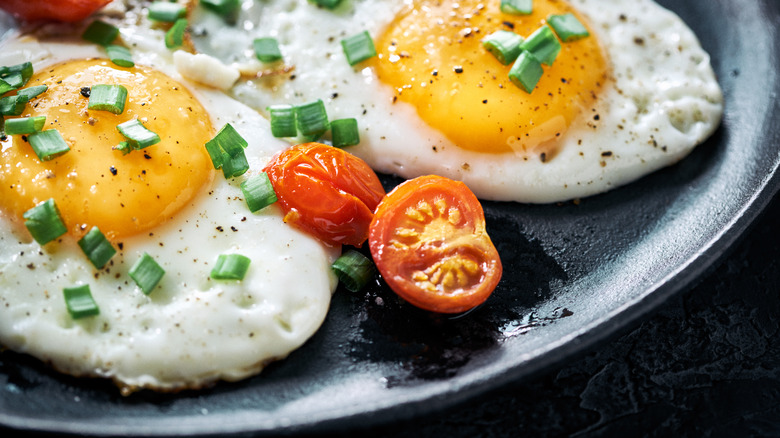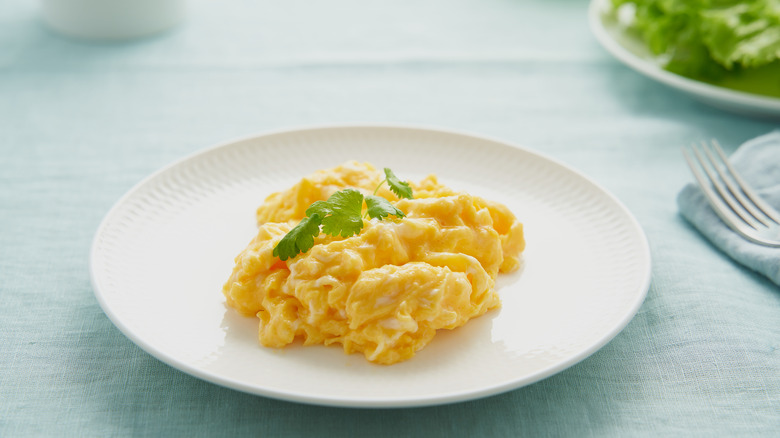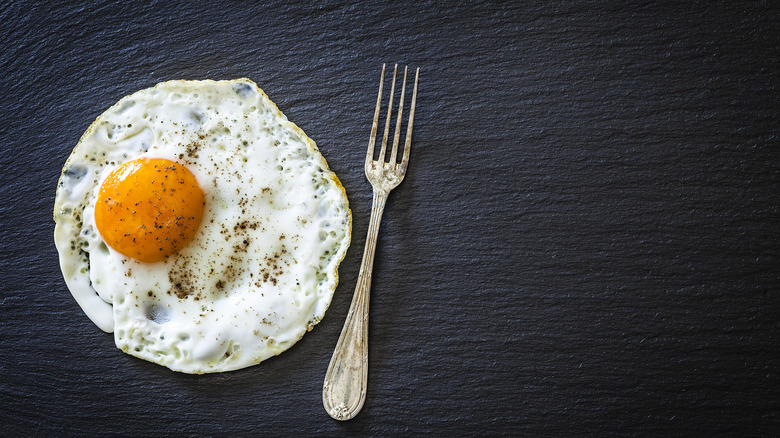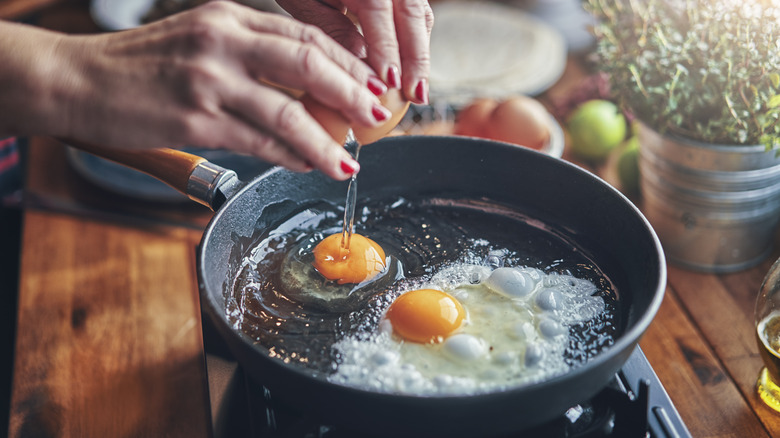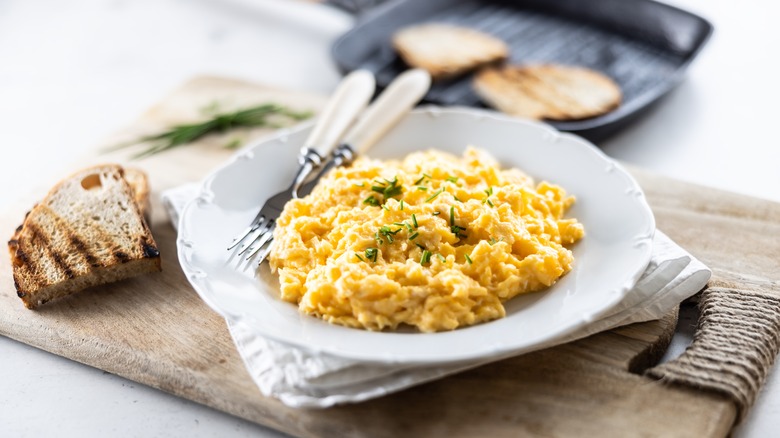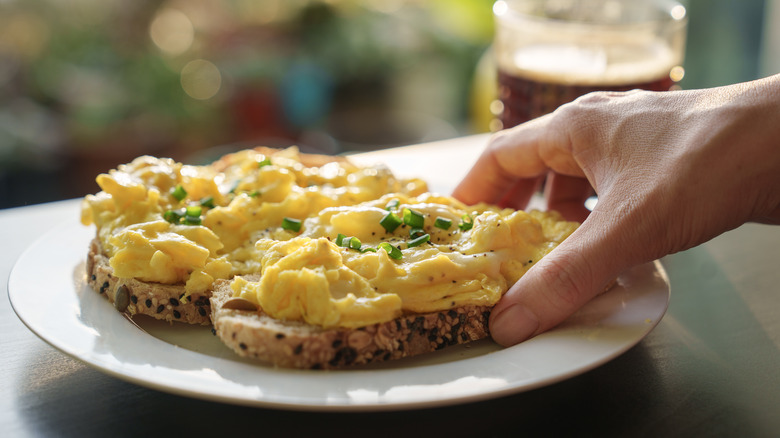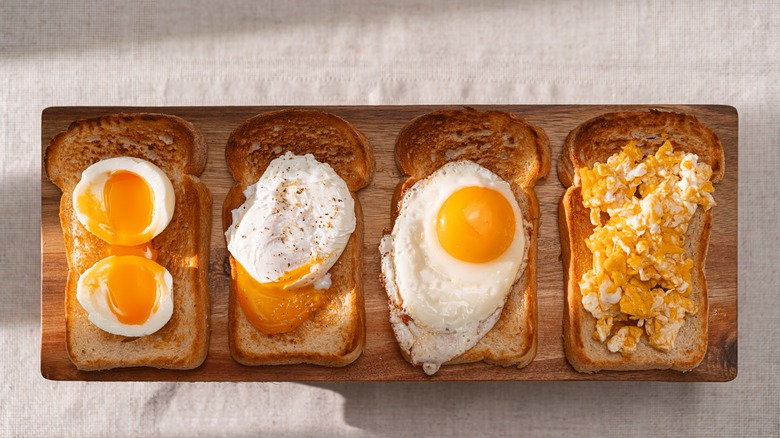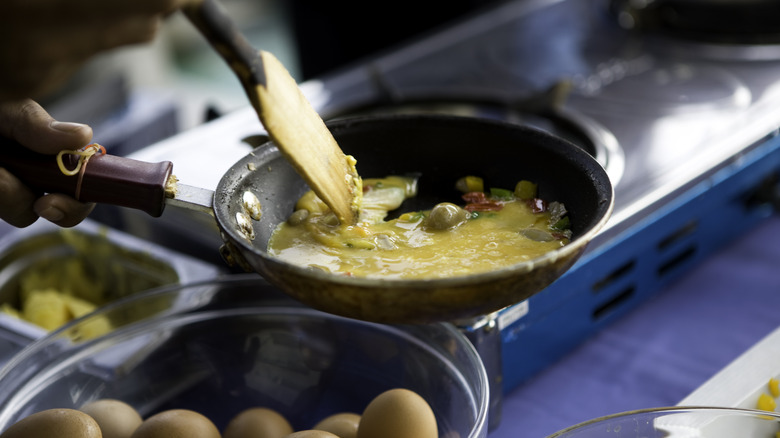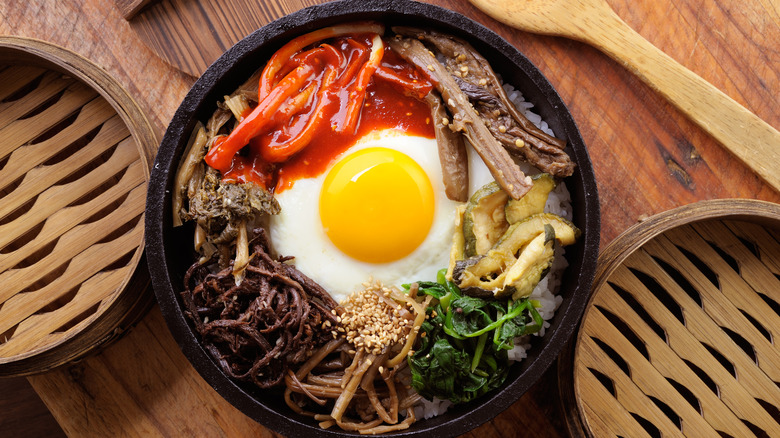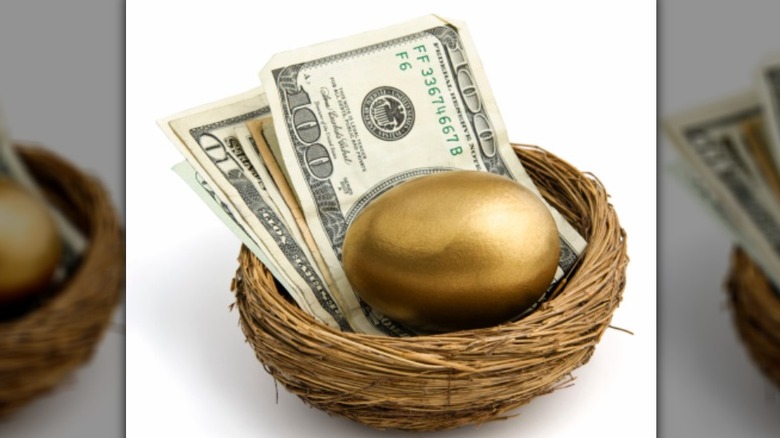Scrambled Eggs Vs Fried Eggs: Everything You Need To Know
Because of their nutritional value and tasty flavor, eggs are an easy addition to any meal, from early breakfasts to quick midnight snacks. They are a versatile staple of many world cuisines and readily available from the supermarket or backyard flock.
More than 60 types of chickens lay edible eggs, but that's not the only option. Ostrich, duck, emu, and goose eggs (and rarer varieties like crocodile and gull eggs) are also used in baking and at the breakfast table. Regardless of the variety, eggs are packed with protein. Eggs also have calcium and folate, both of which make them great nutrition for people who are pregnant.
But the cooking technique makes all the difference here. When considering whether to scramble or fry your eggs, the main difference lies in the preparation. From this basic difference, every other difference arises, including taste and the various uses of the final product. Some eggs lend themselves to one preparation or the other. For example, making a family-sized portion of scrambled quail eggs would be a budget buster, but frying an ostrich egg, which can weigh up to 3 pounds, would take extraordinary skill and proficiency with a spatula when it comes time to flip. If you're debating whether to whip up a vat of scrambled eggs or throw a few fried eggs in the pan, here are some things to keep in mind.
What are scrambled eggs?
The scrambled form of eggs is one of the most common ways people eat this tasty staple. Yolk and white are vigorously whisked together — hence the name — before cooking in a skillet and serving.
Gordon Ramsey's scrambled eggs are legendary. He cooks them in lots of butter in a deep saucepan over low heat, scraping the pan with a spatula (no whisk) and moving them constantly as the temperature increases, forming soft curds gradually. He toggles back and forth from the pan on direct heat and off, moving from one to the other every 30 seconds. Once the eggs are nearly done, he moves them from the heat entirely and stirs in a generous dollop of crème fraîche. The resulting creamy, pillowy, soft-scrambled eggs melt in your mouth.
But not everyone enjoys slow-cooked soft scrambled eggs. Some chefs prefer to quickly make them over high heat rather than taking their time. The amount of color on the egg ranges from none to just beginning to brown, but rarely more than that, and most chefs agree that any color is the mark of an improperly cooked egg. One thing the majority of cooks agree about is the pan. Nonstick pans are important. Eggs are fragile, and the possibility of them sticking to a pan is suboptimal. If nonstick pans are unavailable — and even if they are — adding a little fat to the pan ensures smooth, easy release, no matter which methods or tricks you use.
What are fried eggs?
Fried eggs are the most elemental of all egg preparations. Whole eggs are cracked into a hot pan that is usually dressed with some sort of fat. Eggs are flipped once – or not, depending on how the eater prefers them. Fried eggs keep the two main elements of the egg — the egg yolk and whites — separate and allow them to really shine with just a little salt and pepper.
First, the yolk. Old-school fried egg fans like it one way: just warmed and very runny, perched proudly atop a pristine circle of white. This sunny-side-up egg, where an egg is cracked into the pan and left until the bottom is cooked and the whites are just set, is the simplest type of fried egg, but after that, you have a variety of options. Over easy, over medium, or over hard indicates the firmness of the egg yolk and the egg white.
Egg whites are also in the spotlight on a fried egg. A sunny-side-up preparation requires a very fresh egg because the white will sit firm and not be runny, but all fried eggs require the freshest egg for the best results.
Cooking techniques
The cooking technique of scrambled eggs vs fried eggs is the major difference. One creates a blank slate upon which to sprinkle just a little seasoning or strew with a variety of fillings and toppings, and the other keeps it simple and showcases the egg itself.
Scrambled eggs take the former path. Eggs are whisked vigorously together, combining yolk and white until indistinguishable. This method makes good use of eggs that might be slightly past their prime or those with imperfections in the yolk. The cooking technique of scrambling changes the flavor of the eggs because both parts are so completely incorporated as not to distinguish one from the other. Scrambling also creates a more uniform texture, which can change the perception of the taste, if not the taste itself.
On the other hand, fried eggs are designed to maintain a rigorous separation between yolk and white. The extra surface area of the white browns in the pan provides one texture, while the yolk and its varying degrees of runniness provide another. Fried eggs are generally also cooked in a very hot pan with fat added to ensure the egg does not stick, and this fat adds another layer of flavor. Both techniques can be challenging to master, though. Creating the perfect soft scramble with overcooking part of the scrambled eggs is challenging, but flipping an egg without breaking the yolk causes misery and frustration until you master the technique.
Nutrition information
On paper, scrambled and fried eggs have the exact same nutrition. In fact, if you whisk two eggs together and cook them in a teaspoon of olive oil, you'll have the same exact nutrition as two fried eggs cooked in a teaspoon of olive oil.
The difference comes when scrambled eggs are doctored up to make something altogether different. Because of their mild, neutral taste, scrambled eggs are the perfect canvas upon which to paint a variety of flavors from across the globe. Feta, sun-dried tomatoes, and a garnish of chopped fresh basil bring a taste of the Mediterranean to your breakfast table. A tortilla, some black beans, fresh avocado, and raw diced red onion are a spicy way to travel south of the border without leaving your table. But these additions change the dish's fat content, making the eggs less than healthy.
Fried eggs can also take some additions. For example, frying your eggs in a dollop of pesto instead of olive oil or no fat at all changes the nutritional content, as does adding a teaspoon or two of chili crisp to the finished product. Most fried eggs are served simply, with a piece of toast or two for dipping. But scrambled eggs do have one healthy option going for them: You can remove the yolk to reduce saturated fat. Egg yolks technically have more protein than egg whites, but the volume of egg whites makes up for the missing yolk.
The taste is everything
When it comes down to it, taste is subjective. It's impossible to argue with a person when they say scrambled eggs taste different than fried, but there may be some grain of truth in this case. Differences in seasoning and the use of fat or add-ins aside, the cooking technique alters the taste of these two types of eggs.
When it comes to scrambling, egg white has less flavor than the yolk. Think of scrambling as the white slightly diluting the intense taste of the yolk. And regarding frying, the Maillard reaction that occurs when a fried egg begins to brown — a color that is not optimal on scrambled eggs — changes the taste of the egg.
And finally, the appearance of the egg and the texture itself can change a person's perception of the taste. Suppose all other factors were equal, meaning there was no Maillard reaction and all seasonings were the same. In that case, it is possible that the superficial appearance of a fried egg versus a scrambled egg could influence how a person perceived the taste. Again, it's hard to gauge what's real science and what's a person's preference.
You can't ignore the texture
The role of texture in how food tastes is of considerable debate for many people and is not restricted to what might be considered picky eating in childhood. In fact, some adults suffer from avoidant-restrictive food intake disorder (ARFID), and texture is one of the reasons why some people cannot handle certain types of food (even if they like the taste).
Scrambled and fried eggs have very distinct textures, and how they are cooked can make a big difference. The same person who enjoys eggs scrambled hard might gag at the thought of a soft scramble. And those who love an over-medium fried egg might respond similarly when facing a sunny-side-up fried egg. But the texture of scrambled eggs is generally more accessible for more people than the runny yolk and just-set white of a fried egg. Parents routinely feed eggs as one of their child's first foods, both for their finger-friendliness and nutrition. It is possible to cook fried and scrambled eggs to a different level of firmness to make them more palatable for people who like the taste but struggle with the texture. When cooking a fried egg, removing the specific offensive texture (either the white or the yolk) and enjoying the nutritional and taste benefits of what remains is also possible.
Cooking time
Both scrambled and fried eggs are the perfect solution to a last-minute meal. Within 15 minutes, either can be on the table for a busy family or people on the go. But there are some differences in the cooking times. Although there is some debate about whether scrambled eggs should be cooked over high or low heat, most professional chefs prefer to move slowly when scrambling their eggs. This means that cooking times are extended depending on your temperature. Additionally, it is recommended that salt be added to eggs at least 15 minutes before cooking to dissolve and help eggs retain their perfect moisture level as they cook, so this adds to the hands-off prep time of an otherwise speedy meal.
In a race, fried eggs of any kind (sunny-side-up to over-hard) would win. It's simply the faster technique, limited only by the speed with which your pan heats up. Raw eggs should sizzle and jump when they hit the pan, in sharp contrast to the slow beauty of a scrambled egg.
Ease of preparation
Yes, both of these preparations are relatively simple on the surface. But there's a reason why some professional chefs gauge the skill of amateur cooks by how they prepare an egg. It's easy to produce scrambled eggs that are dried out and burnt, and breaking a yolk is a common disaster regardless of skill level in the kitchen.
But when it comes down to it, scrambled eggs are easier. It's often the first dish that parents and children cook together on the stove, for good reason. With minimal manual dexterity, small hands can easily manipulate a whisk or a fork to mix egg and yolk together. After that, it's a matter of stove safety only. Scrambled eggs are a satisfying dish to learn to cook because they are so simple and appropriate for cooks of all ages and skill levels. Once the basic scramble is mastered, cooks can then move on to more complicated dishes that use a base of scrambled eggs, including omelets.
Uses for scrambled eggs and fried eggs
The ubiquity of eggs across cultures is reflected in the myriad ways they are used. Scrambled eggs are brilliant when wrapped in a tortilla with cheese and bacon. They are also major players in Japanese cuisine, appearing as tamagoyaki (a rolled omelet also known as tamago). Scrambled eggs (sometimes referred to as stir-fried eggs due to the way in which they are prepared) are also one of the finishing touches on fried rice.
Fried eggs are no slouch in cuisines, both foreign and domestic. They are the crowning glory in scalding hot stone bowl bibimbap and the drippingly delicious center of a fried egg sandwich. Fried eggs anchor the full English breakfast and top dosas and parathas in India. In Ecuador, llapingachos — potato, yucca, or cassava pancakes stuffed with cheese and fried — are finished with a perfectly cooked fried egg.
Because scrambled eggs are generally looser, they do well when encased in a tortilla or bread (or when combined with other ingredients). Fried eggs are perfect when the runny yolk combines with other spices and flavors to create a rich, beautiful sauce.
The budget matters, too
Cooking on a budget can be challenging, especially if you are feeding many people three squares a day. It can be even tougher if those people are picky or have specific dietary restrictions or preferences that mean tailoring your grocery list to them.
Because they are so nutritious and versatile, eggs are a solid choice for those with limited funds. But one preparation can stretch your dollar even further: scrambled eggs. Scrambled eggs can be stretched to feed more people by adding a splash of milk, some chopped greens or leftover veggies, or a hunk of cheese.
But a single fried egg is only a single fried egg. Unless it is fried hard, with the yolk and white wholly set, dividing a single fried egg between two hungry diners is impossible. Of course, you can always use fried eggs as a complement instead of the main dish — think adding one to a sandwich or bowl of noodles instead of serving a plate that's just fried eggs. So, while cutting costs with fried eggs can be hard, it is possible. But scrambled eggs are an easy solution to keeping your grocery bill down while providing a healthy, hearty meal.

